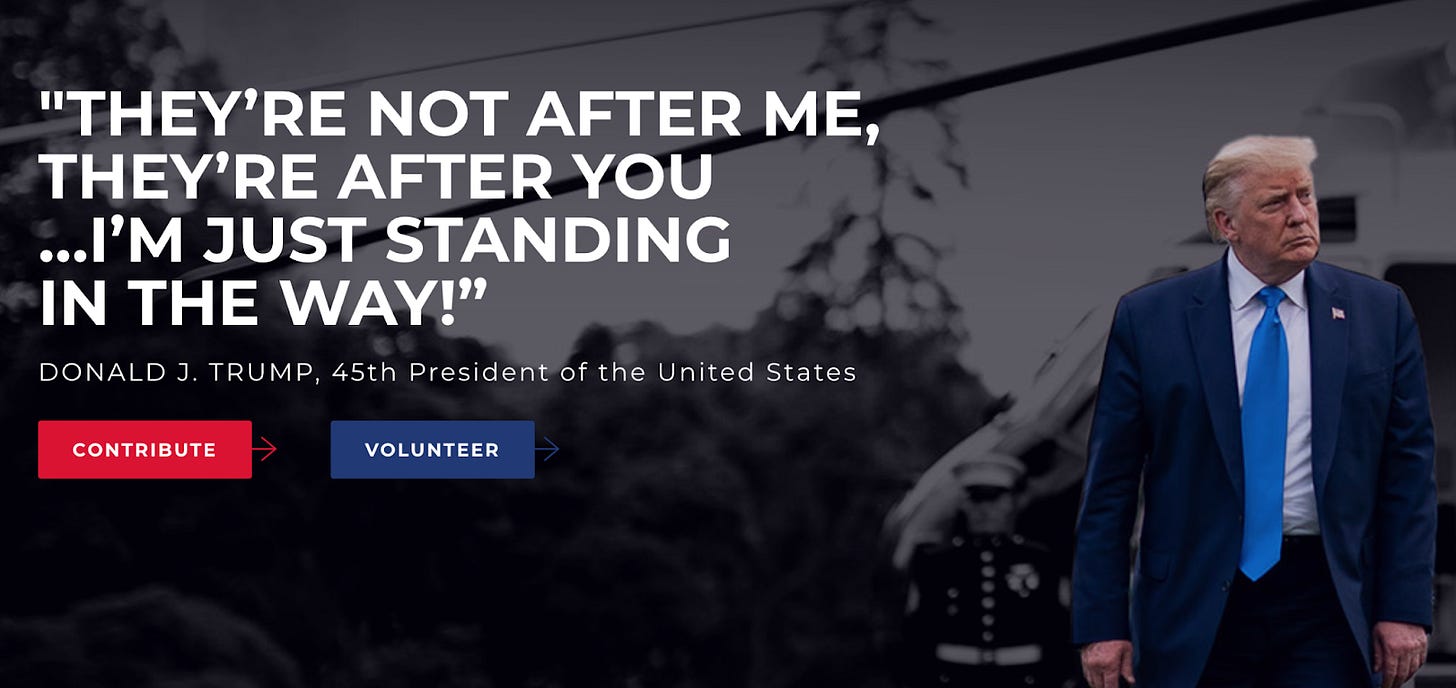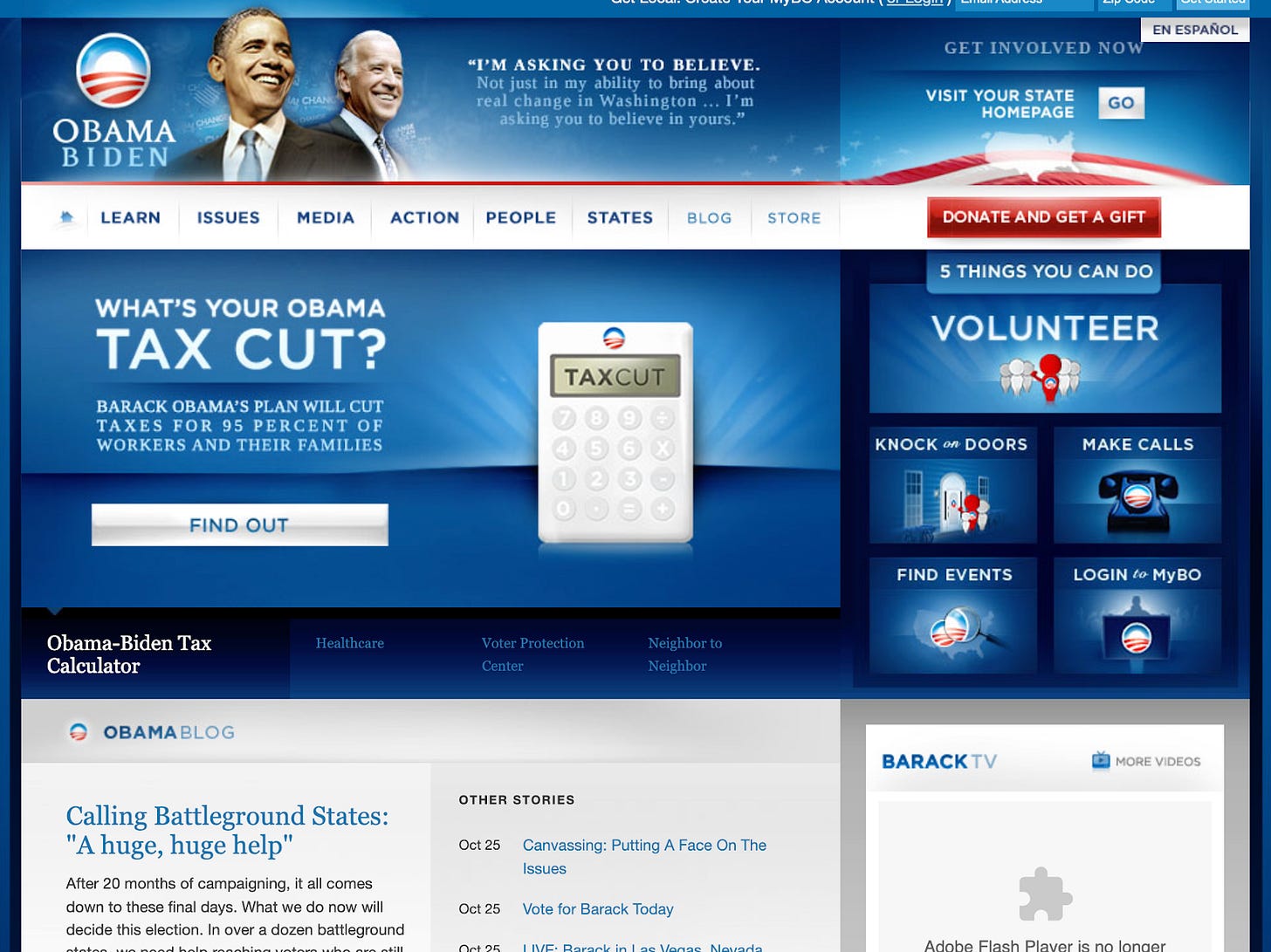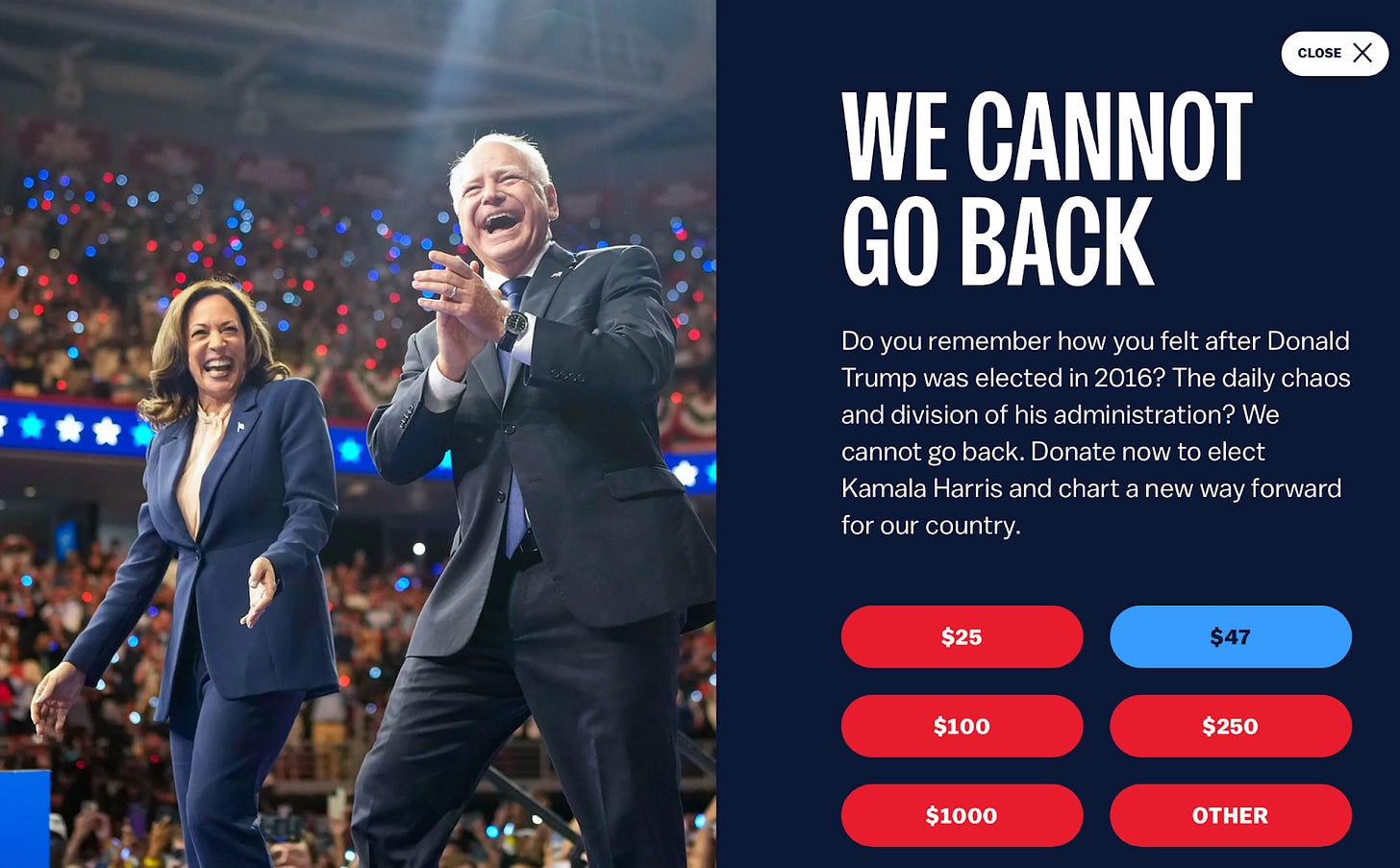Likability isn't enough
Explaining the gap between Harris’s favorability ratings and the head-to-head polls.
We still owe paid subscribers two Model Talks by the end of the week; you can sign up below for those. But for today, it’s another free post. Because I woke up this morning with an epiphany: what the hell is Kamala Harris’s closing message? And then I went to her website and was even more confused. Anyway, I don’t want to overstate the importance of campaign tactics, a lot of which are constrained by the underlying conditions of the race that are outside of the candidates’ control. But I do think this is a problem for her, at least at the margin.
If this election were a popularity contest, Kamala Harris would win.
Harris’s favorability rating is 46.5 percent, according to 538. Donald Trump’s is 43.3 percent. That’s a 3.2-point gap in Harris’s favor.
And Harris’s unfavorability rating is 47.2 percent. Her numbers are basically breakeven; in other words, about as many Americans like her as dislike her, which is pretty rare for a politician these days. Trump’s unfavorability rating is 52.4 percent. So that’s an even bigger difference: a 5.2 point-gap favoring Harris.
And yet, Harris’s lead in national polls is down to just 1.6 points. With a 3-to-5 point national lead, Harris would very probably win the Electoral College. If it’s closer to 2 points, it’s tenuous.
Could the favorability-ratings gap portend room for growth for Harris in the closing days? That some of the few remaining undecided voters will choose her in the privacy of the ballot booth because they think she’s more llikable? Perhaps. If I were making a list of 24 factors that favored Harris — which, by the way, is a tougher assignment than the list I made for Trump — it would be somewhere on that list. But check out this chart:
In 2016, Hillary Clinton also had a larger advantage in favorability ratings than in head-to-head polls against Trump. Now, the shape of this was a little different: Clinton was considerably more unpopular than Harris, but Trump was really unpopular, far more so than he is now. Still, we all know how that worked out for her.1
Trump’s running a Billboard Lawyer campaign
I’m sure you’ve seen those big billboards for plaintiffs’ attorneys: for whatever reason, there are usually lots of them out near the airport. They usually look something like this:
These billboards are not advertising that the attorney is a nice guy. Because you don’t want a nice guy. You’re not trying to win a popularity context. You’re trying to win a lawsuit. You want someone aggressive. Hit back! Get the Gorilla, whatever that means. In fact, you probably expect the plaintiff’s attorney to be a little bit of an asshole. But he’s your asshole. He’s on your side.
You know who this reminds me of?
This is the lead image from Donald Trump’s website this morning. To be fair, to get there, you first have to click through an interstitial asking for donations and showing Trump serving fries at McDonald’s — a decidedly softer image. But fun-loving Trump is a secondary brand. The main brand is he’s an asshole. But he’s your asshole. He’s on your side. Like those plaintiffs’ attorneys, he’s somewhat cleverly owning his abrasiveness and unpopularity. Sure, he’ll take slings and arrows from the (BIASED!!!!!) mainstream media. That’s because they’re elites who are not on your side. Trump fights — for you!
And what’s the message in the same position on the Harris website?
14 DAYS LEFT? What kind of message is that? Well, I’ll tell you. The campaigns assume that most people who visit their websites aren’t swing voters but partisans, and the goal when you capture partisans in your marketing funnel to get them to donate to you. 14 DAYS LEFT stresses the urgency of the campaign.
Still, if you do happen to be a swing voter, you’re getting almost nothing from 14 DAYS LEFT. There’s no message. It feels like they’ve run out of things to say. Instead, there’s a lot of bio. “Meet Kamala and Tim” — not Harris and Walz.
Contrast this with Barack Obama’s page from the same point in 2008:
There’s a lot going on here.2 ACTION! PEOPLE! KNOCK ON DOORS! MAKE CALLS! There is not much bio. But there is a substantive policy proposal. Interestingly enough, it’s for a tax cut — an explicit pivot to the center. And Obama isn’t just asking you to trust him: you can click on a calculator to verify that you’re one of the 95 percent of workers who would be eligible for this tax cut.
OK, then, let’s click on Harris’s “issues” page:
This … isn’t really “issues”? It’s more bio! In case you’re having trouble reading the text:
Vice President Harris and Governor Walz are fighting for a New Way Forward that protects our fundamental freedoms, strengthens our democracy, and ensures every person has the opportunity to not just get by, but to get ahead. As a prosecutor, Attorney General, Senator, and now Vice President of the United States, Kamala Harris always stood up for the people against predators, scammers, and powerful interests. She promises to be a president for all Americans, a president who unites us around our highest aspirations, and a president who always fights for the American people. From the courthouse to the White House, that has been her life’s work.
Well, at least it’s now Vice President Harris and Governor Walz — not Kamala and Tim. But of the four sentences, three are just talking about Harris’s credentials and values — not any substantive sort of agenda.
And the first sentence is a bunch of euphemisms. Our fundamental freedoms. Which ones? Like abortion? That’s a good issue for Democrats, so why not mention it, or at least the term “reproductive rights”? Strengthens our democracy? What does that mean? Well, I know what Harris means, as someone whose job it is to follow the news every day. It means Trump did January 6 and has no respect for the rule of law. But this is some of the same stale messaging from the Biden campaign, which seemed to assume that if you clicked your heels together three times and shouted “DEMOCRACY!”, voters would instantly get it. Polling shows that they don’t: this message resonates with Democrats’ college-educated base but not particularly with swing voters.
By contrast, if you scroll down Trump’s page, here’s what you get:
It’s not the world’s best prose, full of weird Trump Case capitalization. And “Agenda47” is a bad name, reminiscent of “Project 2025”, which Trump has tried to distance himself from. But it makes it very clear what Trump is all about:
America needs determined Republican Leadership at every level of Government to address the core threats to our very survival: Our disastrously Open Border, our weakened Economy, crippling restrictions on American Energy Production, our depleted Military, attacks on the American System of Justice, and much more.
To make clear our commitment, we offer to the American people the 2024 GOP Platform to Make America Great Again! It is a forward-looking Agenda that begins with the following twenty promises that we will accomplish very quickly when we win the White House and Republican Majorities in the House and Senate.
Immigration bad! Inflation bad! Drill, baby, drill! At least there’s some sense of direction here. You can click along to the list of 20 promises — I’ll just show you the first half.
Some of these are empty platitudes. And many are things Trump would not actually be able to accomplish or would actively make worse — his proposed tariffs would contribute to inflation, for instance. But you have no doubt what Trump stands for — whereas that’s actually pretty confusing for Harris.
So Harris is campaigning on personality, and Trump is campaigning on … policy? Not in a wonky, Buttigiegian way, obviously. But at least there are some CLEAR GOALS ARTICULATED IN ALL CAPS rather than Harris’s triangulated language.
This is why it’s not surprising that Harris does comparatively better in favorability ratings than in head-to-head polls — and also why I don’t particularly think there’s any reason to expect that gap to close. Her message is: I’m a likable person, and I’m not Trump, and you’ll just have to trust me to sort out the details. His is: I’m an asshole who fights for you, and here’s a bunch of stuff you’ll get if you vote for me. It’s the Billboard Lawyer message — and there’s a 53 percent chance it will work.
Don’t go back, but also don’t go forward?
One idea I’d been kicking around was for a post headlined “Is Kamala Harris a calling station?” This is a geeky poker term: it refers to a player who often takes the passive actions of checking and calling rather than the more decisive ones of raising, betting, or folding. Nearly all inexperienced players do this: they love to call! But you can’t put pressure on your opponent this way, and it makes you predictable. Mathematically, there are even times when calling is actually the worst of the three plays: you’d be better off either folding or raising.
Is Harris guilty of this? Well, if you look at her website, probably. She hasn’t quite been able to pivot successfully into Incumbent Mode by owning some of the more popular achievements of the Biden-Harris administration. But she also hasn’t tried to distance herself from the unpopular Biden.
And she hasn’t offered a good rationale for the flip-flops from her left-wing 2019 campaign. It might be helpful if she at least tried — saying something like “It’s not a bad thing to change your mind when the evidence changes, and I’ve seen the situation at the border and reconsidered the issue” or “Here’s something where I actually disagree with Joe”.
This may be because she doesn’t want to admit weakness and the media scrutiny it would bring. To be fair, most of us hate to admit weakness, especially men, but women can face a larger penalty for it, and Harris seems to be aware of that.
But what is she doing exactly? The slogan on her landing page is “A NEW WAY FORWARD.” This sort of rhymes, at least, with the motto on her interstitial, “WE CANNOT GO BACK.”
Taken together, however, these are at least a little bit confusing. We cannot go back! But also, we can’t continue on the same path, because it isn’t working out so well either, or at least it isn’t very popular. So let’s try a third thing? A new way forward. I know we said we were driving up to Maine, but maybe we can go to Cape Cod instead. It’s sort of the same, right? But also it sort of isn’t! Or maybe let’s just take the exit and figure out the rest later?
Given more time to explain herself, like in her excellent convention speech, Harris can land this message, particularly by drawing contrasts with Trump. There still isn’t a lot of policy substance, but at least she can go beyond personality to talk about their contrasting values. In soundbite form, though, it’s a tough sell.
Of course, sometimes you do need to call in poker. A lot, in fact: there are occasions when it’s strictly a better play than raising or folding. The most common time is precisely when you might expect: when your hand is simply too good to fold but not good enough to play for a larger pot.3
You can argue that Harris is in exactly this sort of position. The election has been near 50/50 for most of the race since she took over from Biden. She nailed the set pieces of the campaign: quickly consolidating support from Democrats to avoid a contested convention, the convention itself, and then the debate. Since then, the race has slightly drifted away from her. Another debate might do wonders, but Biden screwed that up for her by blowing up the debate schedule, and Trump very well might have blown it up if Biden hadn’t. Meanwhile, Trump has started running out the clock with stunts, like the McDonald’s thing. But it’s still a very close race. Many people have already voted. It’s a little late for a change of plans.
The one thing I still really fault Harris for is picking Walz instead of Josh Shapiro, not just for the Electoral College implications but because Shapiro would have been a bolder choice: a more decisive pivot to the center for a candidate relying on signaling rather than policy proposals.
Apart from that, I don’t know. What about a more substantive agenda on health care, like reintroducing a public option? Well, Harris is probably afraid that it will be mistaken for Medicare for All, which she’s disowned. Maybe more aggressive calls for a cease-fire in the Middle East? Well, she doesn’t want to undermine the White House’s diplomatic efforts, and she’d have to navigate carefully because the public is still generally more sympathetic to Israel than Palestine.
The fact is that Harris has a difficult hand to play. Biden is an unpopular incumbent, and voters are perpetually unhappy with the direction of the country. In fact, we haven’t seen many successful incumbent campaigns lately. There was no incumbent in 2008, and John McCain — despite pivoting aggressively away from George W. Bush — lost in a landslide. Obama won in 2012, but his Secretary of State lost in 2016. Trump lost in 2020. And Biden basically already lost this year: at least Democrats were smart enough to fold their clearly losing hand.
Harris also has some advantages. Trump is unpopular. And she’s successfully rebranded from what was once a poor public image. But she’s having more trouble distancing herself from her previous policy positions and the problems of the Biden-Harris administration. Maybe running on vibes was the best bet — but the election is a toss-up, and she’d better hope the coin comes up heads.
This is slightly complicated by the fact that Clinton underperformed her polls in 2016 — but the errors were mostly at the state level. National polls were quite accurate.
At the risk of turning this into a web design seminar, some of this is because web design best practices have evolved toward “cleaner” designs that give the user fewer choices of where to click on. But I’m not sure this is always an improvement. Some of these designs are designed for designers rather than users.
In game theory, the way to avoid being exploited by this is to also sometimes call with strong hands — to trap or “slowplay” — but many intermediate players don’t do this sufficiently often.













Is it weird to you that your whole brand is data-driven journalism but you’re increasingly writing articles that aren’t much more than your own punditry?
Nate Silver uses an awful lot of column inches on something that's very easy to sum up. In fact, he hit the nail on the head early in this essay. We are not voting for the homecoming king. We are voting for the president of the United States.
When you push into the reasons that people actually pulling the lever for Donald J Trump give, a common thread connects all of these voters. All of them are pissed off. The system does not exist to serve them. It doesn't matter how many platitudes you throw out there. It doesn't matter how much the S&P 500 went up this year. These people don't have multi-million dollar 401ks, and they don't have 15% of their assets tied up in the stock market.
They want somebody who is going to fight for them and hopefully win for them. They don't even think for sure that Trump will win. But at least he isn't getting elected and immediately forgetting them.
When you contrast that with Kamala Harris, people are left with a stark choice. Vote for abortion, or vote for someone willing to possibly fight to keep them from dying from starvation, in a gutter, from a fentanyl overdose, or whatever.
Donald J Trump is Saul Goodman.